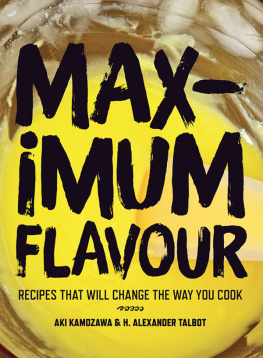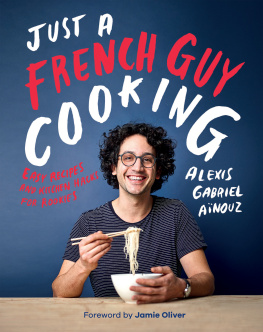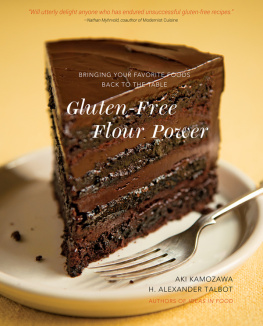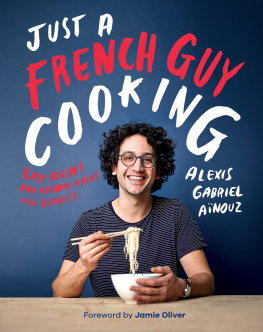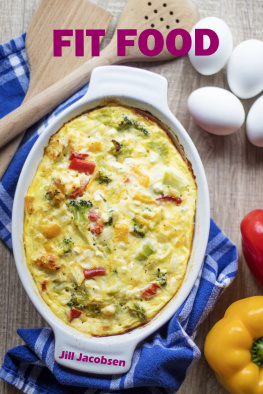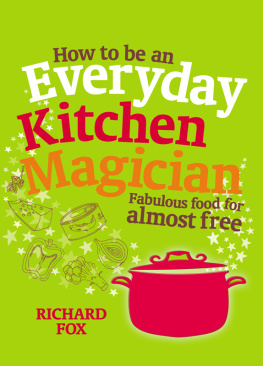ACKNOWLEDGMENTS
The decisions we make and the directions we choose in life are not as random as they may appear; we have been guided by many people. First I must thank my parents, Karen and David, for cooking so well and being passionate about food. They had me hooked on delicious from day one. Grandma Kitty and her television show, Cooking with Kitty, provided a playground for a toddler becoming aware of what is possible. From those early days she has always encouraged me to work hard while following my dreams. Our family friend Tom Haas was instrumental in getting me into a professional kitchen and it was Lenny Phillips who instilled the drive to succeed in the kitchen into my head. Doron Wong deserves many thanks for keeping me on the path to improve and chase perfection. It was in the kitchen of Clio working with Ken Oringer where I learned the need for continuous tasting and research. Ken pushed me to look down all avenues of food and lift every possible rock for inspirations. He also hired Aki, which allowed us to meet, and well Finally, without Aunt Maries unwavering belief in Aki and myself, many of our accomplishments would have never been possible.
H. Alexander Talbot
As a little girl I always loved to cook. Food was my passion. Even as a child I gravitated toward books with great food from the Little House series by Laura Ingalls Wilder to the All-of-a-Kind Family books by Sydney Taylor. It was no great stretch to imagine that one day I would write books about food. I was lucky enough to be surrounded and supported by a family that loves food as much as I do and for that I thank Mom, Aunt Marie, and Uncle Steve. You were the best parents I ever could have asked for. Claire was a late entry to the family circle. In my early twenties, when I got a little distracted by life in the city, shes the one who pushed me to refocus my energy and lent me the money I needed to go to the culinary school in Vermont I had been talking about for years. A special mention for Barbara, Peg, and Bob who went out of their way to be there for us at a time when we needed them most and are always there when I need them now.
The New England Culinary Institute was a great experience for me and I have to thank both the staff of the school and the friends I made there. They were always ready to answer my questions and provide support when I needed it. A special acknowledgment has to go out to Mark Molinaro, who was my block mate both years, a good friend, and a good cook who wasnt afraid to lecture me when he felt I needed it, something I didnt always appreciate at the time. Chef David Hale was both an inspiration in the classroom and integral in helping me secure my internship at Clio in Boston, where I worked for Ken Oringer and met Alex. I learned more in Kens kitchen than anywhere else before: that a good palate is as important as practical knowledge, that there is no substitute for hard work, that all the details matter, and that there is always something more to learn. These are lessons that have stayed with me ever since. Eddie and Steve taught me the ropes in garde manger and made me feel at home in a place where I easily could have been overwhelmed. Their willingness to share their knowledge inspired me to do the same for others.
Of course there is no book without Alex. Our greatest collaboration is our daughter, Amaya, but this book is a close second. It captures the essence of all the things we both love about food and cooking. Its always a pleasure to spend time with him, in the kitchen and out. Shared passions tend to push us to greater heights than either of us would reach alone.
Aki Kamozawa
We both would like to thank Marco Canora and Laura Sbrana for giving us the keys to their kitchen. Those two summers proved to us that anything is possible. Beth and Warren Busteed deserve a big nod of appreciation for dealing with our youthful aspirations. Even though we ultimately had to part ways, they took a chance on us and gave us the opportunity to do things our way with minimal interference. Barbara and Alan Sackman encouraged us to push ourselves to improve constantly and gave us a wonderful kitchen in which to do so. Barbara especially was an unwavering supporter of both our food and our dreams for the future. Wylie Dufresne deserves a huge thanks for giving us our first container of meat glue, introducing us to the concept of hydrocolloids, eloquently pointing out the benefits of using a scale, and being a sounding board for ideas in the rough. Michael Chaffin is a good friend who is also a believer; he introduced us to the concept of a blog and encouraged us to pursue one of our own. Without Michael there would not be an Ideas in Food.
Thank you to John Mahoney for taking a chance on our writing skills and offering us an opportunity to work with Popular Science. There are not enough words in this space to thank our editor, Rica Allannic, for her passion and drive in this project. She never would have found us if Michael Anthony hadnt graciously pointed her in our direction. Rica introduced us to our agent, Sharon Bowers, who helped us organize our book in a smart and approachable way and then supported us through the sometimes painful process of writing and publication. Thank you to Ashley Phillips and the entire Clarkson Potter team who helped cull through all of our ideas and shape them into what this book has become. Danya Henninger helped us organize our digital vision and is still making the website look better than we ever could.
A big thank you goes out to all of the family and friends too numerous to list here. You know who you are and why we love you. Thank you to all of the cooks who have worked with us through the years; weve learned something from every one of you. Finally, a heartfelt thank you to all of the readers of our website, whose questions force us to look deeper and learn more about everything we do in the kitchen. Without the ongoing conversations with chefs, enthusiasts, idealists, and eccentrics we would not have been able to produce this book.
FURTHER READING
Aberle, Elton David, John C. Forrest, David E. Gerrard, and Edward W. Mills. Principles of Meat Science, 4th ed. Dubuque, IA: Kendall Hunt, 2001.
Adra, Ferran, Juli Soler, and Albert Adra. El Bulli 2003. Spain: RBA Libros SA and Ecco, 2005.
Alford, Jeffrey, and Naomi Duguid. Flatbreads & Flavors: A Bakers Atlas. New York: William Morrow, 1995.
Anderson, Pam. The Perfect Recipe. Boston: Houghton Mifflin, 1998.
Arbuckle, W. S. Ice Cream, 2nd ed. Westport, CT: AVI Publishing, 1972.
Barham, Peter. The Science of Cooking. New York: Springer, 2001.
Beranbaum, Rose Levy. The Cake Bible. New York: William Morrow, 1988.
Blumenthal, Heston. Family Food. London: Penguin Books, 2002.
. The Fat Duck Cookbook. London: Bloomsbury, 2008.
Boi, Lee Geok. Classic Asian Noodles. Singapore: Marshall Cavendish Cuisine, 2007.
Brown, Amy. Understanding Food: Principles and Preparation. Belmont, CA: Wadsworth Thomson Learning, 2000.
Bugialli, Giuliano. Bugialli on Pasta. New York: Stewart, Tabori & Chang, 2000.
Carluccio, Antonio. Antonio Carluccios Passion for Pasta. London: BBC Books, 1993.
Carroll, Ricki. Home Cheesemaking. North Adams, MA: Storey Publishing, 2002.
Charley, Helen, and Connie Weaver. Foods: A Scientific Approach, 3rd ed. Upper Saddle River, NJ: Prentice Hall, 1998.
Clarke, Chris. The Science of Ice Cream. Cambridge, UK: RSC Publishing, 2008.
Clayton, Bernard, Jr. The Complete Book of Breads. New York: Simon and Schuster, 1973.
Colwin, Laurie. Home Cooking: A Writer in the Kitchen


